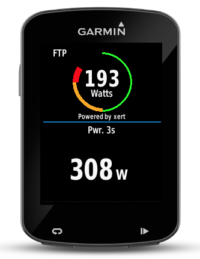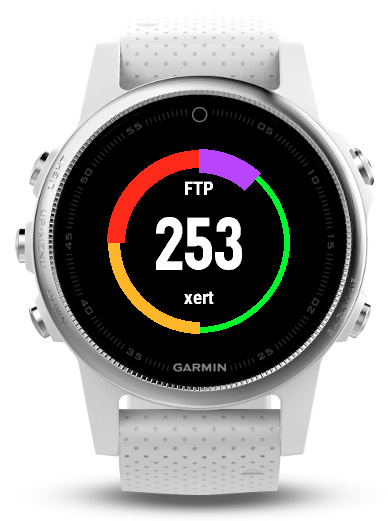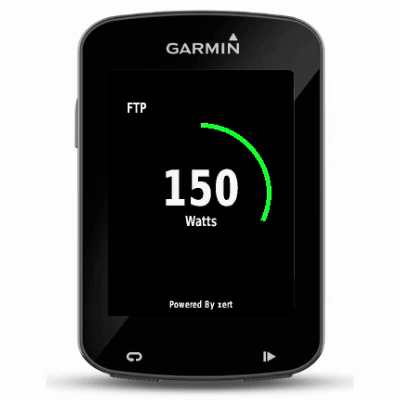Never Do An FTP Test – The Sequel
With Xert, there’s no longer a need for traditional FTP tests. When we first launched this concept it was quite remarkable because athletes often planned and performed specific ‘tests’ on a regular basis during both training and racing seasons in order to determine their fitness and performance expectations. There are still many that use lactate testing with blood sampling to determine FTP.

In 2017, we announced a new Garmin data field called “What’s My FTP?” with another novel and powerful approach to determining an athlete’s FTP: we can detect it in real-time, on-the-fly using your power data!
How Does the App Work?
Xert’s WMFTP data field doesn’t require an Xert account or complex setup. Simply install the data field on your Garmin device, and you’re ready to go. This data field works seamlessly across a wide range of Garmin devices such as bike computers & wearables. While it’s best to use a dedicated screen for the data field, you can also pair it with another data field (like 3s Avg Power) to see your current power output and track your FTP as it progressively increases!
The best way to use the data field is during a ride where you know you’ll eventually reach your limit. Whether it’s a training ride, race, or specific test, the app will determine your FTP at the point of failure, where it becomes impossible to push any higher.
You’ll notice that during your ride, race or workout, the dial moves clockwise until it reaches 12 o’clock. Initially, you’ll find it easy to push your FTP number higher. But it will become progressively harder. Eventually, you’ll have a maximal effort and from there on after it will become impossible to push the number any higher. The number displayed will then show your FTP and the dial becomes a fatigue gauge.
Pacing and Recovery
Unlike traditional FTP tests, which require you to sustain your maximum effort without breaks, Xert’s app focuses on how you fatigue and recover. This means you don’t need to pace yourself or worry about intensity levels. Just ride until you can’t go any longer, and the app will give you an FTP value based on your performance.
No More Set Time Limits
FTP is often referred to as the power you can sustain for an hour, but other methods, like the 20-minute test, try to approximate this. Xert’s approach, however, adapts in real-time to your efforts, and while it’s typically close to your 1-hour FTP, it’s more accurate and dynamic, adjusting with your performance as you ride.
Unique Use Cases
The WMFTP data field allows you to reset your FTP during a ride by using the lap button. This is helpful for tracking the effects of long-term fatigue during rides, such as after a 4-hour effort, or testing how different conditions—like hydration or bike positioning—affect your FTP. You can even test FTP on different bikes to compare results!
Getting the Best Results
To get an accurate FTP reading, we recommend following this general protocol:
- Warm up: Start with any warm-up routine, including one or two hard efforts.
- Peak Power Effort: Perform several out-of-the-saddle Peak Power sprints (~10 seconds each) with short rests in between to push your peak power. This helps prime your body for maximal effort.
- For the best result, on a road with a good surface, ride towards a slight uphill at a fairly high speed and average cadence, then select one gear harder just before you arrive at the incline and as you hit the bottom of it, jump hard out of the saddle and go as hard as you can for at least 10 seconds. It’s important that you post a number that represents something near your maximum power. Rest for a few minutes between sprints.
- Longer Effort: Ride hard for several minutes to generate fatigue and lower your MPA (Maximal Power Available). Then, push to your limit for a maximal effort.
- If you have MPA on your bike computer, bring your MPA down to about 400W above your Threshold Power.
- If you don’t have MPA as a guide, ride hard for several minutes until you feel like you’re going “deep into the red” i.e. you feel like you’re getting close to cracking. A climb is great for this, but a longer stretch of road without stoplights or stop signs also work well.
- Max Effort: Take a brief rest (or not) and do a maximal effort. This is the toughest part, but be sure to execute this well. Go as hard as you can out of the saddle until you reach ‘failure’. This can be over a few minutes long or just 20s, it doesn’t matter.
- Recover & Repeat: If you didn’t reach ‘failure’, briefly rest (not full recovery) and repeat if you wish to make sure you have your best FTP result!
- Cool Down: End with a proper cool-down to help your muscles recover and flush out any lactate build-up.
Want to Track Your FTP and Do More?
Xert offers a 30-day free trial to help you track your FTP and explore more powerful training tools. Sign up now!
Updated 18 Dec 2024






